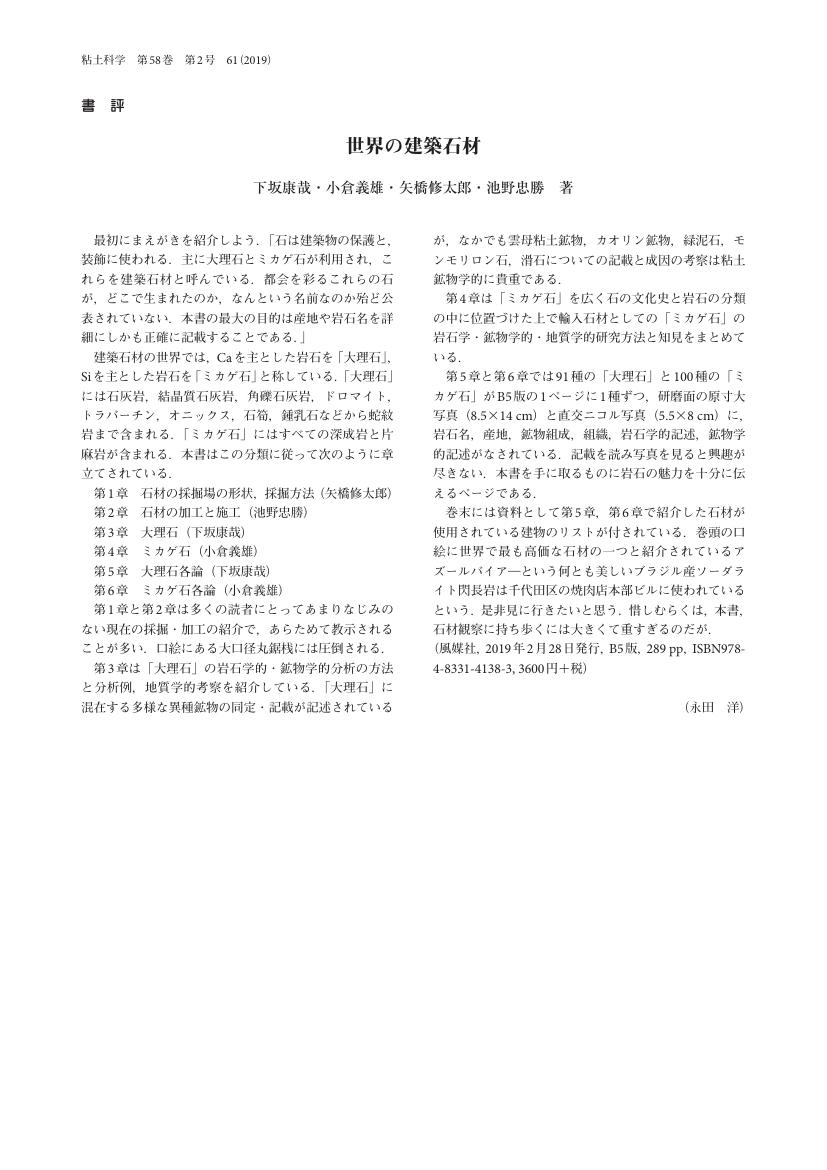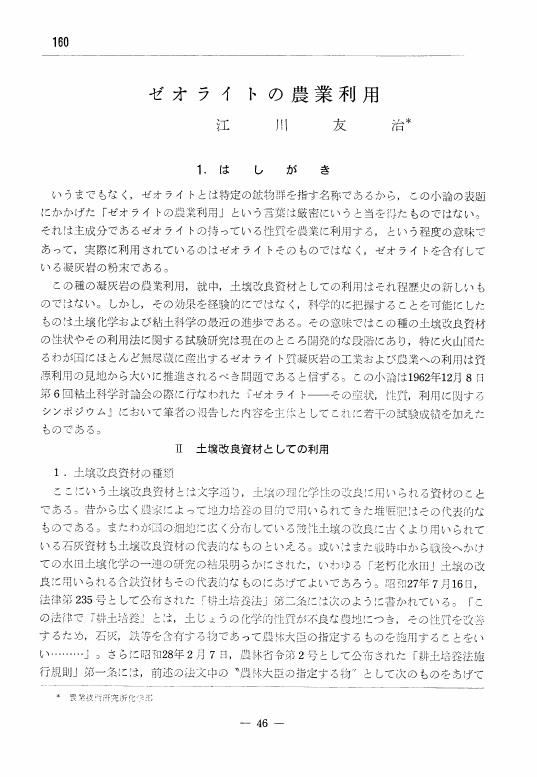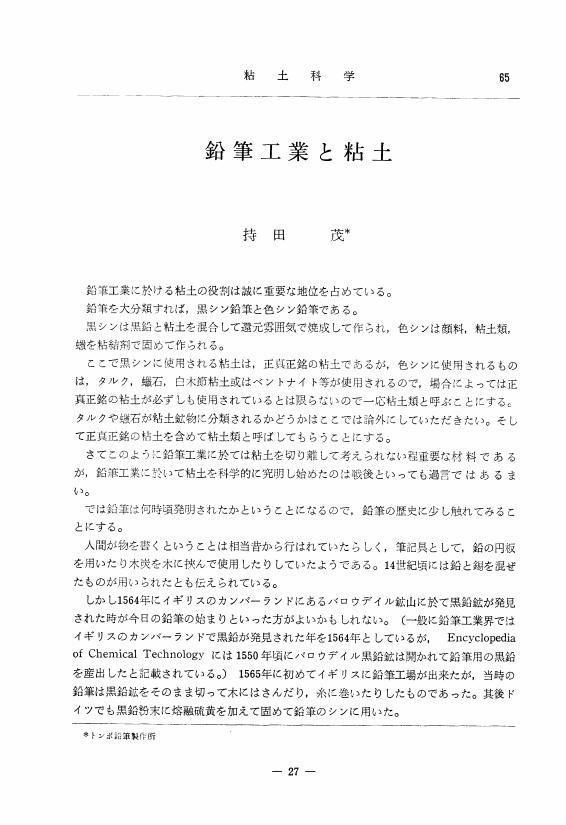2 0 0 0 OA 「世界の建築石材」 下坂康哉・小倉義雄・矢橋修太郎・池野忠勝 著
- 著者
- 永田 洋
- 出版者
- 一般社団法人 日本粘土学会
- 雑誌
- 粘土科学 (ISSN:04706455)
- 巻号頁・発行日
- vol.58, no.2, pp.61, 2019-08-30 (Released:2019-09-03)
2 0 0 0 OA 多賀城跡古代瓦の鉱物学的研究
- 著者
- 大森 啓一 岡田 広吉
- 出版者
- 一般社団法人 日本粘土学会
- 雑誌
- 粘土科学 (ISSN:04706455)
- 巻号頁・発行日
- vol.18, no.2, pp.40-50, 1978-06-25 (Released:2011-09-20)
- 参考文献数
- 9
An old castle named Tagajo was founded between the 8th and 11th Centuries in Miyage Prefecture, Japan. Roofing tiles were unearthed from the ruins of castle and old oven, which were studied by mineralogical methods.Roofing tiles used in the study were classified from archaeology into two groups, one of which was the I era tiles and the other the II, III and IV era tiles. Every tiles were 12 to 34mm in thickness. The I tiles were homogeneous with light dark color and the others inhomogeneous roughly with ashy color. In every tiles many porphyritic quartz crystals were found in association with plagioclase, hornblende, augite and magnetite under a microscope. Their groundmasses consisted of quartz and glassy materials.Textures were found to be fluidal, banded and microfolded in the I tiles, and were more notable than those of the II to IV tiles. From X-ray diffraction patterns the presence of quartz, plagioclase, cristobalite and mullite was detected. From chemical analyses all compositions concentrated on a small area centered at 70% SiO2, 20% Al203 and 10% the others in the triangle phase diagram. Refractorinesses of every tiles were found to be under SK 26. Water absorptions of these tiles satisfies a requirement of the JIS standard for roofing tiles.From these results it was found that the fired temperatures were between 1, 000° and 1, 200°C and the techniques making roofing tiles progressed from the I era to the II to IV eras.
1 0 0 0 OA 土壌の溶融生成物の鉱物学的および化学的特性
- 著者
- 万福 裕造 八田 珠郎 矢板 毅 佐藤 努
- 出版者
- 一般社団法人 日本粘土学会
- 雑誌
- 粘土科学 (ISSN:04706455)
- 巻号頁・発行日
- vol.56, no.2-3, pp.28-40, 2017-12-25 (Released:2018-01-15)
- 参考文献数
- 26
In this study, we examined the mineralogical and chemical properties of the 11 soils weathered from different rock-types and Kanto loam, and their properties after heat treatment at 1550°C.The constituent mineral of the weathered soils does not necessarily reflect the mineral and chemical compositions of the host rock. The sum of SiO2, Al2O3, Fe2O3 in the weathered soil shares a considerable ratio as weathered materials while it's not necessarily reflect the chemical composition of the base material rock.With heat treatment of the 11 weathered soils and Kanto loam at 1550°C, the considerable weight loss and phase change was observed. The minerals produced after heating at 1550°C were mullite, cristobalite, hematite. While cristobalite is formed from all soils, mullite and hematite were existed after limited soil treatment. From this chemical weathering index (WI), the formation of mullite from the soil where the weathering is considerably advanced was clarified.The correlation between the formation of hematite and WI is not clear, but the dependence of the content of Fe2O3 is considered. After the heat treatment, significant weight loss was observed in the soils containing large amount of Fe2O3, weathered from andesite, basalt, gabbros, serpentinite, limestone as base materials and Kanto loam. It is thought that it depends on the difference of the content of clay minerals, the dehydration due to the change of clay minerals etc., and the reduction of iron (III) oxide. The basic data obtained in this study are considered to be important for future direction toward the heat treatment and volume reduction of the actual radioactive Cs-contaminated soil in Fukushima Prefecture.
- 著者
- 小暮 敏博
- 出版者
- 一般社団法人 日本粘土学会
- 雑誌
- 粘土科学 (ISSN:04706455)
- 巻号頁・発行日
- vol.54, no.1, pp.22-27, 2015-08-21 (Released:2017-06-22)
- 被引用文献数
- 3
Although more than four years have passed after the accident at the Fukushima-Daiichi nuclear power plant, the state of radioactive cesium, which is the main source of the high radioactivity in the environment of Fukushima, is not well understood yet. To advance this situation, we tried to specify radioactive soil particles using IP autoradiography and electron microscopy. As a result, the radioactive soil particles were classified into three types from their morphologies and chemical compositions: (1) conglomerates of fine clay minerals, (2) organic matter containing clay mineral particulates, and (3) weathered biotite with a platy shape originated from granite. The weathered biotite is actually a biotite-vermiculite mixed-layer mineral, forming a porous structure with well-developed cleavage, and kaolinite filling the cleavage spaces. It was indicated that radioactive cesium is located uniformly in the weathered biotite, rather than concentrated around the edges of the platy shape.
1 0 0 0 第21回IUPAC化学熱力学国際会議(ICCT-2010)
- 出版者
- 一般社団法人 日本粘土学会
- 雑誌
- 粘土科学 (ISSN:04706455)
- 巻号頁・発行日
- vol.48, no.2, 2009
1 0 0 0 OA 膨潤性粘土鉱物の特徴 : 鉱物としての見方(地盤工学会・技術者交流特別セッション)
- 著者
- 井上 厚行
- 出版者
- 一般社団法人 日本粘土学会
- 雑誌
- 粘土科学 (ISSN:04706455)
- 巻号頁・発行日
- vol.47, no.3, pp.161-167, 2008-11-07 (Released:2017-06-22)
- 参考文献数
- 8
1 0 0 0 ゼオライトの農業利用
- 著者
- 江川 友治
- 出版者
- 一般社団法人 日本粘土学会
- 雑誌
- 粘土科学 (ISSN:04706455)
- 巻号頁・発行日
- vol.2, no.3, pp.160-167, 1963
1 0 0 0 第59回粘土科学討論会(山口大会)報告
- 著者
- 川俣 純 沢井 長雄 谷 誠治 鈴木 康孝 富永 亮
- 出版者
- 一般社団法人 日本粘土学会
- 雑誌
- 粘土科学 (ISSN:04706455)
- 巻号頁・発行日
- vol.54, no.2, pp.74-79, 2016
1 0 0 0 OA 粘土の成因 (I) 概説および風化作用
- 著者
- 岩生 周一
- 出版者
- 一般社団法人 日本粘土学会
- 雑誌
- 粘土科学 (ISSN:04706455)
- 巻号頁・発行日
- vol.12, no.1, pp.31-44, 1972-04-25 (Released:2011-09-20)
- 参考文献数
- 30
1 0 0 0 OA ゼオライトの農業利用
- 著者
- 江川 友治
- 出版者
- 一般社団法人 日本粘土学会
- 雑誌
- 粘土科学 (ISSN:04706455)
- 巻号頁・発行日
- vol.2, no.3, pp.160-167, 1963-06-01 (Released:2011-09-20)
- 被引用文献数
- 1
1 0 0 0 第53回粘土科学討論会・懇親会参加申込書
- 出版者
- 一般社団法人 日本粘土学会
- 雑誌
- 粘土科学 (ISSN:04706455)
- 巻号頁・発行日
- vol.48, no.1, 2009
1 0 0 0 OA 鉛筆工業と粘土
- 著者
- 持田 茂
- 出版者
- 一般社団法人 日本粘土学会
- 雑誌
- 粘土科学 (ISSN:04706455)
- 巻号頁・発行日
- vol.1, no.2-3, pp.65-68, 1961-08-01 (Released:2011-09-20)
- 参考文献数
- 2
- 著者
- 八田 珠郎
- 出版者
- 一般社団法人 日本粘土学会
- 雑誌
- 粘土科学
- 巻号頁・発行日
- vol.53, no.1, 2014
1 0 0 0 OA 塩およびカチオン性ポリマーを含むスメクタイト分散液の粘度変化と乳化能に関する研究
- 著者
- 関根 知子
- 出版者
- 一般社団法人 日本粘土学会
- 雑誌
- 粘土科学 (ISSN:04706455)
- 巻号頁・発行日
- vol.54, no.1, pp.1-8, 2015-08-21 (Released:2017-06-22)
Liquid paraffin was added to 3 kinds of smectite dispersions containing different amount of salt to prepare emulsions. Stable emulsions were obtained when the smectite particles aggregated to make the dispersions turbid or almost were segregated with salt. Smectite and cationic cellulose were mixed and then the mixtures were investigated as salt tolerance thickener and emulsifier. The smectite-cationic polymer complex could act as thickener even if the complex dispersion contained 3 wt% of NaCl. The complex dispersion viscosity increased as the molecular weight of the added cationic polymer increased. Finer droplet emulsion was obtained with smectite-cationic cellulose complex containing 3wt% NaCl compared to the smectite emulsion.
- 著者
- 鈴木 正哉
- 出版者
- 一般社団法人 日本粘土学会
- 雑誌
- 粘土科学 (ISSN:04706455)
- 巻号頁・発行日
- vol.50, no.2, pp.81-87, 2011
- 参考文献数
- 12
- 著者
- 金城 和俊 島田 晴加
- 出版者
- 一般社団法人 日本粘土学会
- 雑誌
- 粘土科学
- 巻号頁・発行日
- vol.56, no.1, pp.1-7, 2017
<p>Minami-daito island, which is situated in a sub-tropical area, contains red-yellow soil. Recently, grayish white-colored soil was discovered around dead roots in the subsoil on the island. In general, grayish white-colored soil is formed via iron dissolution by a low molecular-weight aliphatic carboxylic acid solution (LACA) in a cold setting; however, there were few studies regarding the formation of white-colored soil in sub-tropical areas. The objective of this study is to elucidate the mechanism of grayish white-colored soil formation in the sub-tropical setting of Minami-daito island. Soil samples (horizons Ap<sub>1</sub>, Ap<sub>2</sub>, B<sub>1</sub>, and B<sub>2</sub>) were obtained from a pumpkin field on Minami-daito island. Grayish white-colored soil was discovered around dead roots in the B<sub>2</sub> horizon, which was also collected. From X-ray analysis, the clay minerals were kaolin minerals, mica, vermiculite, vermiculite–chlorite integrate, and goethite in the A and B horizons; however, goethite was not present in the white-colored soil. This result indicates that the grayish white-colored soil was formed by the dissolution of goethite around dead roots. It is likely that LACA is necessary for the dissolution of goethite in soil. To prove this hypothesis, a leaching test was conducted. Oxalic acid, formic acid, and acetic acid in LACA and samples of the B<sub>2</sub> soil horizon were used for the leaching test. Compared with H<sub>2</sub>O treatment, Al and Fe were dissolved using LACA treatment and oxalic acid solution treatment. From X-ray analysis, it was observed that the gibbsite and goethite peaks obtained using LACA treatment were smaller than that using H<sub>2</sub>O treatment. In particular, the goethite peak disappeared after oxalic acid treatment. Previous studies have demonstrated that oxalic acid has a high ability to dissolve goethite. It is concluded that the grayish white-colored soil on Minami-daito island was formed via the dissolution of goethite by oxalic acid from plant dead roots.</p>
1 0 0 0 OA 天然ゼオライトの合成
- 著者
- 中島 和一 上田 智
- 出版者
- 一般社団法人 日本粘土学会
- 雑誌
- 粘土科学 (ISSN:04706455)
- 巻号頁・発行日
- vol.30, no.1, pp.57-75, 1990-04-24 (Released:2011-09-20)
- 参考文献数
- 110
- 被引用文献数
- 1
Heulandite-clinoptilolite, analcime-wairakite, mordenite and ferrierite are main natural zeolites which are widely distributed. We have reviewed histories of synthetic study on the main natural zeolites, and mineralogical properties and formation conditions of the natural zeolites synthesized.
- 著者
- C. J. FORDHAM I. J. SMALLEY
- 出版者
- 一般社団法人 日本粘土学会
- 雑誌
- Clay Science (ISSN:00098574)
- 巻号頁・発行日
- vol.6, no.2, pp.73-79, 1983 (Released:2011-09-20)
- 参考文献数
- 9
Thermogravimetric studies on the St. Jean Vianney clay from Quebec, Canada, have indicated four major thermal events. These events are best presented by means of the Derivative Thermogravimetric (DTG) curve which, until now, has been presented primarily as a histogram DTG plot. However, the tangent DTG plot gives greater distinction between thermal events and locates nine thermal events; the original four as well as five sub-events. A comparison of two quickclays, the St. Jean Vianney clay and a Norwegian clay, using the tangent DTG plot shows the complex mineralogical nature of the Canadian quickclay, while the Norwegian clay appears to have a relatively simple mineralogy.




